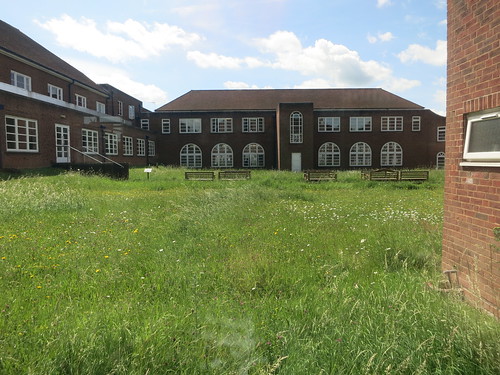There is a special magic about walking through a building and suddenly glimpsing a startle of green through an internal window and realising that in the middle of internal life the external has leaked in, bright and fuzzy, a smoosh of ribald life and growth in the cool humaniform busyness. You have found a quad, a lightwell, an accessible roofspace, a courtyard, an atrium and its openness and light have driven a small clearing-back of humanity and a small interposition of the natural world.
They are seldom very natural of course. Most are gardened, the occasional wild one an accident of non-access or of neglect. Many have specific purposes, tasks and objectives; shading, cooling, airflow and more numinous concepts like wellbeing and mental health boosts. I say numinous, but you can measure the benefits of greenery, greenspace, open air, nature exposure. It's proven and yet somehow still feels indulgent. Perhaps the indulgence is a part of the benefit.

None work harder than hospital gardens. The Derriford Secret Garden, opening its arms to exhausted workers, with wide paths to wheel ICU patients between the raised beds. The Royal Derby Garden, with its cheerful murals and safe, accessible doorways. Kings is creating a rooftop garden, Salisbury has its Healing Garden, all chasing benefits to staff, family, visitors and patients.
But I would go beyond just requiring this for healing spaces. I would say this: all places humans are require secret gardens. All home spaces, work spaces, living spaces need green spaces. From seventieth storey flats to underground bunkers, from open plan offices to busy warehouses, it is not enough to have access to green areas or views of greenery (though both are good things in themselves), there must be space for enclosed green, the safe warm sheltered space of a secret garden.

It can be indoors, in a space congenial for pot plants, or lit for hydroponic growing, why not? The student pot plant, at its most basic, is a bare marker for this item, the methadone of gardens, a tiny green drop that sustains you between spaces where there is space for proper green. But I would propose a minimum set of items:
Buildings without gardens within them are missing something that makes them and their inhabitants thrive more completely, and the clue is in the metaphops that come in from the garden and sprout in workplace well-being discussions; grounding, growth and shoots of bright green irrepressible hope.
They are seldom very natural of course. Most are gardened, the occasional wild one an accident of non-access or of neglect. Many have specific purposes, tasks and objectives; shading, cooling, airflow and more numinous concepts like wellbeing and mental health boosts. I say numinous, but you can measure the benefits of greenery, greenspace, open air, nature exposure. It's proven and yet somehow still feels indulgent. Perhaps the indulgence is a part of the benefit.

None work harder than hospital gardens. The Derriford Secret Garden, opening its arms to exhausted workers, with wide paths to wheel ICU patients between the raised beds. The Royal Derby Garden, with its cheerful murals and safe, accessible doorways. Kings is creating a rooftop garden, Salisbury has its Healing Garden, all chasing benefits to staff, family, visitors and patients.
But I would go beyond just requiring this for healing spaces. I would say this: all places humans are require secret gardens. All home spaces, work spaces, living spaces need green spaces. From seventieth storey flats to underground bunkers, from open plan offices to busy warehouses, it is not enough to have access to green areas or views of greenery (though both are good things in themselves), there must be space for enclosed green, the safe warm sheltered space of a secret garden.

It can be indoors, in a space congenial for pot plants, or lit for hydroponic growing, why not? The student pot plant, at its most basic, is a bare marker for this item, the methadone of gardens, a tiny green drop that sustains you between spaces where there is space for proper green. But I would propose a minimum set of items:
- Safe space to sit, and simply be surrounded by greenery
- Space to grow your own food or flowers, to touch and get your hands dirty
- Space where you can smell the soil, leaves and flowers
- Space to view, where the full field of vision is surrounded by green
- Space where life is growing in a self-directed way (e.g. insects, small fish)
That first stipulation, that the space should be safe, is a pertinent one in the assessment of the benefit of publicly accessible green space. A garden is private and safe. Parks are public space, and subject to the negotiations and contingencies of the commons. Everyone needs some of both kinds of green -- the safe, internal secret garden, as well as the open green spaces to run and play.
Buildings without gardens within them are missing something that makes them and their inhabitants thrive more completely, and the clue is in the metaphops that come in from the garden and sprout in workplace well-being discussions; grounding, growth and shoots of bright green irrepressible hope.

No comments:
Post a Comment